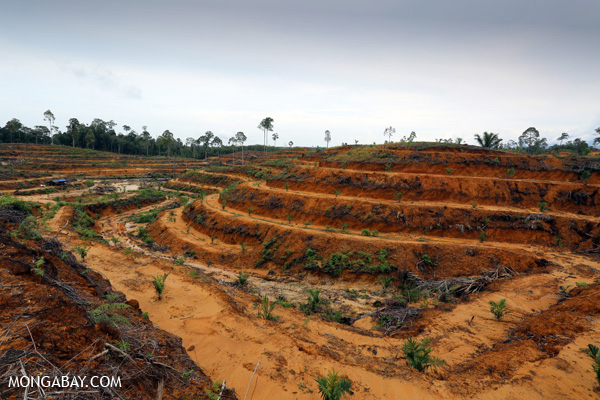Green revolutions have spared land in the past, but might not in the future
Agriculture is the primary driver of tropical deforestation. Indeed, most global food production occurs in the tropics, including important commodity crops such as sugarcane, soybeans, palm oil, and beef. Recent estimates indicate that forest clearing for agriculture contributes significantly to greenhouse gas emissions. This fuels concern over how to balance food production for a growing population with climate change mitigation through conserving tropical forests.
Increasing food supplies while minimizing the environmental impact of clearing for agriculture is a major global challenge. Many researchers have evaluated how new agricultural technologies and intensive production practices affect greenhouse gas emissions following land clearing. One interpretation, the Borlaug hypothesis commonly referred to as land sparing, argues that intensification of agricultural production is better for the environment overall because it spares natural areas by producing more food on less land. However, this hypothesis has been criticized for failing to consider the greater environmental impact of chemically intensive agricultural systems, for example, nutrient pollution of waterways, and the negative effects of monocropping on wildlife habitat.

Newly planted oil palm plantation in Aceh Sumatra Indonesia. Photo by Rhett A. Butler.
Critics also say land sparing assumes that demand for food is fixed. In contrast, several studies of land use change show that increases in agricultural productivity are frequently accompanied by expansion of the land area under cultivation, a process dubbed Jevon’s paradox.
According to Thomas Hertel, an agricultural economist at Purdue University, these conflicting interpretations result in part from differences in the scale of analysis.
“Up to this point, there have been two separate schools of thought about the environmental impacts of agricultural innovations,” Hertel said. “Agricultural scientists have taken a global perspective and argued that improving yields spares land and therefore improves the environment. Ecologists and geographers have generally focused on local impacts and argued that improving yields boosts profitability, increases the rate of deforestation and therefore degrades the environment.”
Hertel and his colleagues helped to shed light on the dilemma in a recent study published in the Proceedings of the National Academy of Sciences (PNAS).
“We show that much of this previous work was misleading due to failure to take a global perspective, as well as the confounding of correlation and causation,” Hertel explained.
The researchers argue that past research evaluating the Borlaug hypothesis was flawed for two reasons. First, studies measuring expansion of agricultural land area following intensification have not accounted for the expansion that would have occurred without it. To remedy this, scientists would need to compare the expansion following an agricultural innovation to a counterfactual [EK1], or an alternate scenario [JLH2] that projects what would likely have happened in its absence.

Soy farm in Villavicencio Colombia. Photo by Rhett Butler.
A second issue is that past studies tended to focus on particular regions, but neglected the impacts elsewhere of regional innovations on land use and CO2 emissions. In the context of an integrated global economy, important spillover effects are often overlooked.
In order to address these gaps in analysis, Hertel and his colleagues used a model of global land use based on agricultural commodity prices to examine the historical record of the Green Revolution in Asia, Latin America, and the Middle East. The model simulates cropland change over the period 1961–2006 based on global demand for agricultural products, regional market segmentation, changes in population, and per capita income, as well as variable combinations of land and other agricultural inputs.
Based on their model’s results, they suggest that the Green Revolution did indeed spare land: yield gains offset additional expansion of agricultural land that would otherwise have been necessary to match global demand.
However, their model also predicts that agricultural innovations are unlikely to spare land or emissions when they occur in regions where both yields and emissions efficiencies are relatively low, and land supply is highly responsive to price changes. They point out that these are precisely the conditions that apply to sub-Saharan Africa today.
Hertel noted that in the context of an integrated global economy, a future Green Revolution there “will lead to stronger expansion of production in Africa, in lieu of cropland expansion in other regions. Since sub-Saharan Africa currently has low levels of environmental efficiency (grain produced on newly converted land vs. carbon released through land conversion), this could lead to increased [greenhouse gas] emissions.”
Their study emphasizes that associations between historical changes in yield and area need to be compared to counterfactual scenarios. They also point to the importance of market integration in determining whether agricultural innovations reduce or increase land use and greenhouse gas emissions.
From Hertel’s perspective, “As the world becomes more ‘flat’ in the words of NY Times pundit Thomas Friedman, the scope for changes in technology to generate perverse environmental outcomes increases. In the long run, the only way to combat this problem is to have global environmental standards. In the case of land conversion for agriculture, a global REDD+ program aimed at protecting the world’s carbon rich forests would go a long way toward reducing the danger of the perverse environmental outcome which we highlight in our paper.”

Cow in the Pantanal in Mato Grosso, Brazil. Photo by Rhett Butler.
While the impacts of logging are relatively transient, hunting pressure is continual, even as an ecosystem approaches complete defaunation. Overall, hunting adversely impacted 87 percent of the species in the study. Improved hunting efficiency and cultural shifts are key components of the potent impact of hunting.
“In the past, nomadic people might have moved out of an area once the game animals became depleted. But now people are more sedentary and settlements are based around opportunities for farming or logging, or access to schools, clinics, and roads,” explained Brodie. “So people have become ‘central place foragers,’ and will continue to hunt in the forest around them even after the animals have been depleted.”
So how do these two threats compare across the Bornean landscape?
Recent selective logging had the strongest negative influence on all species, but after about a decade, these impacts were somewhat attenuated, according to the study. Hunting had a more negative effect in terms of wildlife abundance and richness than older logging.
It is interesting to note that the impacts of hunting and logging were not correlated across species. This, according to the authors, suggests that, “conservation strategies addressing one threat cannot be expected to implicitly mitigate the other.”
According to Brodie, the most significant difference is persistence: “one of the novel things we found in this study was that, whereas the logging impacts are somewhat ephemeral, hunting impacts are surprisingly persistent over time. So hunting continues even in areas that have been really hunted out, probably for recreational or cultural reasons rather than food provisioning per se.”
As tropical rainforest conservation strategies are optimally adapted to maximize effectiveness, this research suggests that the current focus on indirect threats should be expanded to include hunting. In particular, an emphasis on sustainable hunting is needed to adequately protect wildlife populations and biodiversity.
Citations:
- Hertel, T., Ramankutty, N., and Baldos, U. (2014). Global market integration increases likelihood that a future African Green Revolution could increase crop land use and CO2 emissions. PNAS 111(38): 13799-13804.
Erin Kitchell is a Ph.D. student in the Department of Geography at the University of Wisconsin-Madison.
Related articles
Initiative to restore 50M acres of degraded Latin American ecosystems by 2020

(12/07/2014) A coalition of governments and organizations today pledged to restore 20 million hectares (50 million acres) of degraded forests and ecosystems across Latin America by 2020 under an initiative that aims to curb boost rural incomes, fight climate change, and increase agricultural production. The effort is backed by $365 million from five impact investors.
New survey finds surprisingly large population of endangered owl

(12/03/2014) The Anjouan scops owl—an elusive owl found only on its tiny eponymous island—was once considered among the world’s most endangered owls, and even the most threatened birds. However, the first in-depth survey of the owls on the island finds that, in fact, the population is far larger than initially estimated.
Forests as important as farming for some rural communities

(07/14/2014) Forests have long been assumed to provide an important source of income for many of the world’s poor. But determining exactly how forests contribute to rural economies – such as how much income is derived from forests, or how poverty relates to deforestation – has been difficult to pinpoint.